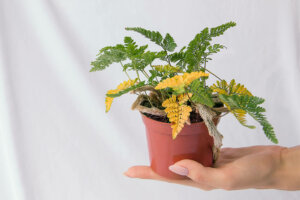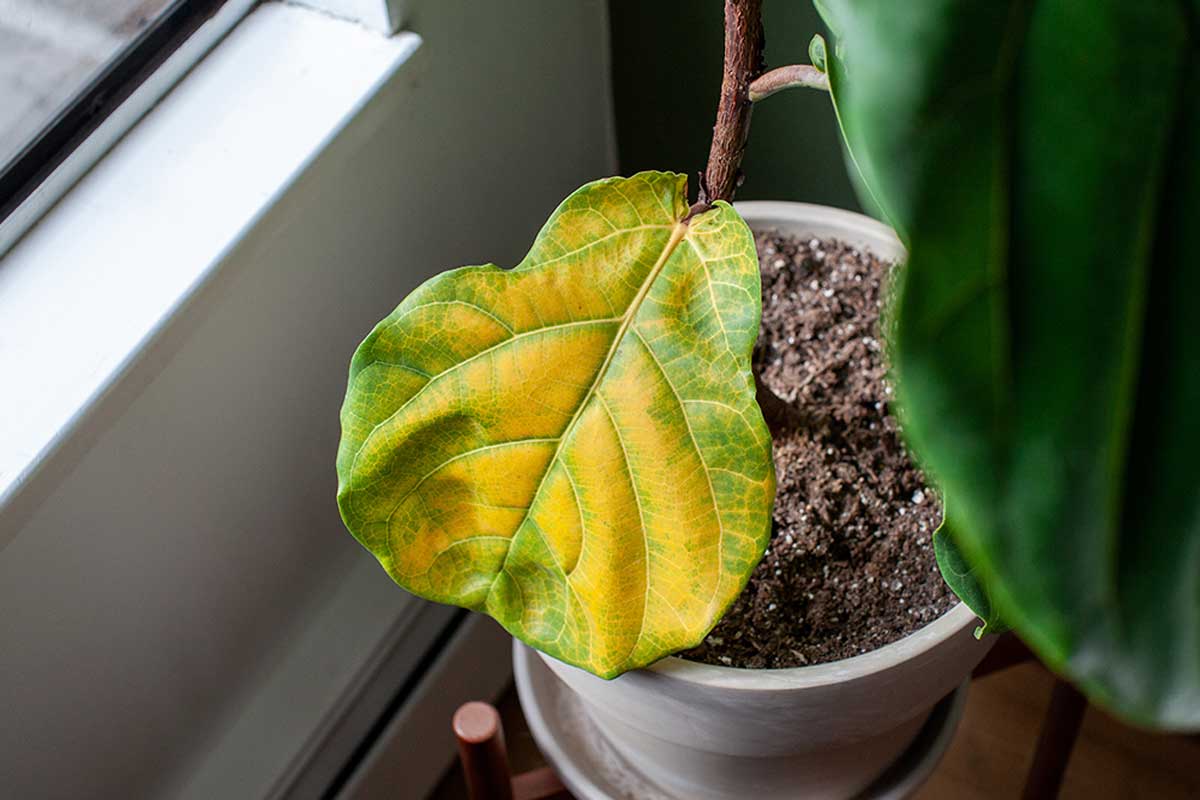Prevent Indoor Plants From Turning Yellow: Home Tricks

Unless you bought yellow houseplants, there’s no healthy reason for your plants to turn yellow. There’s something going on with them. Prevent your plants from turning yellow or identify the current issue in order to help them regain their natural color with these tricks.
If you thought that gardening isn’t your skill and you’re about to throw away your plants… don’t give up so easily! There’s still something else you can do for them and we’ll tell you what it is. Continue reading!
Why do indoor plants turn yellow?

The first thing to do is understand why your indoor plants have turned yellow. Here are the most common causes:
Prevent your plants from turning yellow: you’re not watering them well
Irrigation problems are the most common, especially if you’re just starting out with gardening. The first scenario to contemplate is an excess of water and an inadequate drainage system that’ll make the substrate continuously flood. This may cause the roots of the plant to rot.
The other problem is a lack of watering, which will cause your plants to dry out and they’ll slowly begin to die.
Problems with sunlight
As in the previous case, there are two possibilities. The first is that your plant is receiving a lot of direct sunlight causing it to burn. The second is that it’s not getting the amount of sun it needs to be healthy. If you notice that your plant has yellow tones between dull greens and its leaves are drooping, it’s likely that it lacks sun.
It’s not getting the necessary nutrients
Plants take in the nutrients they need to sustain themselves from the soil and water. If these two elements don’t provide a good amount of potassium, nitrogen, zinc, and magnesium, your plant will start to turn yellow.
For example, in those areas where the water is hard, there’ll be a higher concentration of lime, which, according to studies, can raise the pH of the soil by lowering its acidity. This type of water is harmful to indoor plants because they won’t receive enough iron.
Prevent your plants from turning yellow: the presence of pests
Another reason why your indoor plants can turn yellow is because of the presence of pests. In this case, you should inspect the entire plant to identify if this is the case. Don’t forget about the roots, as there’s a pest known as nematodes, microscopic worms that adhere to it and interrupt the flow of nutrients.
In addition to the yellow color, if you identify spots on the leaves and flowers or that there’s deformation in the stems, you should intuit the presence of pests.
Five homemade tricks to prevent your plants from turning yellow

Okay, now that you know why your indoor plants have turned yellow, it’s time to do something about it. Take note of these simple homemade tricks:
1. Let the water sit for 48 hours
This is the simplest trick. Let the tap water rest for 48 hours so that the calcium crystals precipitate and there is less soluble calcium in the water.
When you’re going to add this water to the plants be very careful not to stir it. Instead, use a kitchen ladle to gently scoop out the water.
2. Acidify the water with vinegar and lemon
To complement the acidification of the water and counteract the impact of the pH of the lime, add to the plant water one teaspoon of vinegar or lemon juice (for each liter of water). Then stir the mixture, let it sit for a couple of hours, and water. You’ll have the same effect if you use nitric acid.
3. Apply compost to your plants
Add compost to the substrate of your plants to ensure good nutrients. One option is coffee grounds, they’re acidic, rich in various nutrients, and prevent hard water from raising the pH. This residue has been widely studied for its impact on soil enrichment.
Another option is to create your own liquid iron. Add half a cup of distilled water, some unused iron screws, and a teaspoon of sulfur to a plastic bottle. Stir and let time work its magic, after a week you should have a very black liquid, mix a little with water, and water the plants.
4. Prevent your plants from turning yellow: give them sunlight in balance
Each plant is different, but in general, they need doses of light and dark in balance. If your plant is always in the shade, try giving it sunbaths during the day. If, on the other hand, it’s always in the sun, it may be in need of some shade.
5. Control irrigation
It’s important that you control the irrigation, if you’ve been watering too much, you can identify the humidity of the substrate by touch. Make sure it has drainage and make small holes under the pot to release the water. If the substrate is dry, try to water more often than you’ve previously been doing it.
Keep your indoor plants from turning yellow!
Now you know why your indoor plants turn yellow and you have the tips to fix it. Give them a try and identify which one has the greatest effect. Of course, when talking about pests, it’s best to fumigate or separate the plant from any others, as pests can contaminate them.
Unless you bought yellow houseplants, there’s no healthy reason for your plants to turn yellow. There’s something going on with them. Prevent your plants from turning yellow or identify the current issue in order to help them regain their natural color with these tricks.
If you thought that gardening isn’t your skill and you’re about to throw away your plants… don’t give up so easily! There’s still something else you can do for them and we’ll tell you what it is. Continue reading!
Why do indoor plants turn yellow?

The first thing to do is understand why your indoor plants have turned yellow. Here are the most common causes:
Prevent your plants from turning yellow: you’re not watering them well
Irrigation problems are the most common, especially if you’re just starting out with gardening. The first scenario to contemplate is an excess of water and an inadequate drainage system that’ll make the substrate continuously flood. This may cause the roots of the plant to rot.
The other problem is a lack of watering, which will cause your plants to dry out and they’ll slowly begin to die.
Problems with sunlight
As in the previous case, there are two possibilities. The first is that your plant is receiving a lot of direct sunlight causing it to burn. The second is that it’s not getting the amount of sun it needs to be healthy. If you notice that your plant has yellow tones between dull greens and its leaves are drooping, it’s likely that it lacks sun.
It’s not getting the necessary nutrients
Plants take in the nutrients they need to sustain themselves from the soil and water. If these two elements don’t provide a good amount of potassium, nitrogen, zinc, and magnesium, your plant will start to turn yellow.
For example, in those areas where the water is hard, there’ll be a higher concentration of lime, which, according to studies, can raise the pH of the soil by lowering its acidity. This type of water is harmful to indoor plants because they won’t receive enough iron.
Prevent your plants from turning yellow: the presence of pests
Another reason why your indoor plants can turn yellow is because of the presence of pests. In this case, you should inspect the entire plant to identify if this is the case. Don’t forget about the roots, as there’s a pest known as nematodes, microscopic worms that adhere to it and interrupt the flow of nutrients.
In addition to the yellow color, if you identify spots on the leaves and flowers or that there’s deformation in the stems, you should intuit the presence of pests.
Five homemade tricks to prevent your plants from turning yellow

Okay, now that you know why your indoor plants have turned yellow, it’s time to do something about it. Take note of these simple homemade tricks:
1. Let the water sit for 48 hours
This is the simplest trick. Let the tap water rest for 48 hours so that the calcium crystals precipitate and there is less soluble calcium in the water.
When you’re going to add this water to the plants be very careful not to stir it. Instead, use a kitchen ladle to gently scoop out the water.
2. Acidify the water with vinegar and lemon
To complement the acidification of the water and counteract the impact of the pH of the lime, add to the plant water one teaspoon of vinegar or lemon juice (for each liter of water). Then stir the mixture, let it sit for a couple of hours, and water. You’ll have the same effect if you use nitric acid.
3. Apply compost to your plants
Add compost to the substrate of your plants to ensure good nutrients. One option is coffee grounds, they’re acidic, rich in various nutrients, and prevent hard water from raising the pH. This residue has been widely studied for its impact on soil enrichment.
Another option is to create your own liquid iron. Add half a cup of distilled water, some unused iron screws, and a teaspoon of sulfur to a plastic bottle. Stir and let time work its magic, after a week you should have a very black liquid, mix a little with water, and water the plants.
4. Prevent your plants from turning yellow: give them sunlight in balance
Each plant is different, but in general, they need doses of light and dark in balance. If your plant is always in the shade, try giving it sunbaths during the day. If, on the other hand, it’s always in the sun, it may be in need of some shade.
5. Control irrigation
It’s important that you control the irrigation, if you’ve been watering too much, you can identify the humidity of the substrate by touch. Make sure it has drainage and make small holes under the pot to release the water. If the substrate is dry, try to water more often than you’ve previously been doing it.
Keep your indoor plants from turning yellow!
Now you know why your indoor plants turn yellow and you have the tips to fix it. Give them a try and identify which one has the greatest effect. Of course, when talking about pests, it’s best to fumigate or separate the plant from any others, as pests can contaminate them.
All cited sources were thoroughly reviewed by our team to ensure their quality, reliability, currency, and validity. The bibliography of this article was considered reliable and of academic or scientific accuracy.
- Carrillo, J. Valoración de la efectividad de los residuos de café sobre la respuesta hidrológica del suelo mediante ensayos en laboratorio con lluvia artificial. Universitat Politécnica de Valencia. 2019
- Acidez y encalado de los suelos. Informaciones agronómicas Núm. 20.







